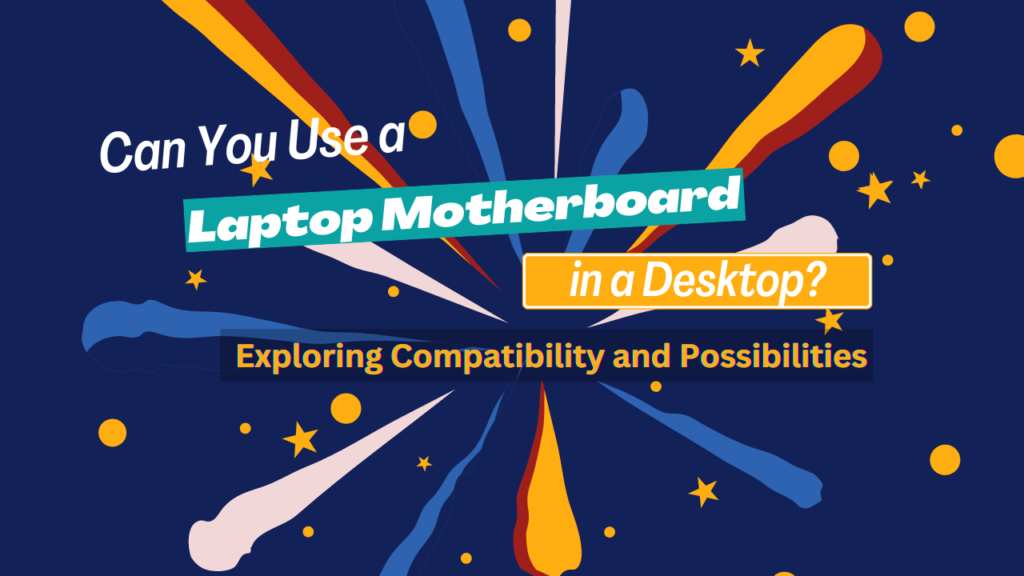
Can You Use a Laptop Motherboard in a Desktop?Laptops and desktops are two different types of computers with distinct form factors. While both contain essential components such as a motherboard, CPU, RAM, and storage, the design and layout of these components differ significantly between the two. Therefore, it is generally not possible to use a laptop motherboard directly in a desktop computer. In this article, we will explore the reasons why laptop motherboards are not compatible with desktops and discuss alternative solutions for upgrading or repurposing laptop components.
Understanding the Differences
Laptop motherboards are specifically designed to fit the compact size and layout of a laptop chassis. They are smaller in size and feature different form factors compared to desktop motherboards. Laptop motherboards are customized to accommodate the unique design constraints of laptops, including space limitations, power efficiency, and thermal management.
On the other hand, desktop motherboards are larger and follow standard form factors such as ATX, Micro-ATX, or Mini-ITX. These form factors dictate the physical dimensions, layout, and mounting points of the motherboard. Desktop motherboards also provide more expansion slots, connectors, and power delivery options compared to laptop motherboards.
Physical Incompatibility
The physical dimensions and mounting hole placements of a laptop motherboard are not compatible with standard desktop cases. Laptop motherboards are smaller and feature non-standard layouts, making it impossible to secure them properly within a desktop chassis. The mounting holes, connectors, and other components on the motherboard will not align with the corresponding features on a desktop case.
Additionally, the I/O (input/output) ports on a laptop motherboard are integrated directly onto the laptop’s body, while desktop motherboards rely on rear I/O panels that are part of the desktop case. These differences in physical design and I/O configurations prevent the direct interchangeability of laptop and desktop motherboards.
Component Integration
Laptop motherboards often incorporate specialized components and features to optimize power consumption, enhance portability, and manage heat dissipation. These components are designed specifically for the laptop form factor and are not easily adaptable to desktop environments. For example, laptop motherboards may integrate proprietary cooling solutions, compact power delivery systems, or specialized connectors that are not compatible with desktop components.
Alternative Solutions
While you cannot directly use a laptop motherboard in a desktop, there are alternative solutions to consider if you want to repurpose or upgrade laptop components:
External Enclosures: You can use external enclosures to connect and utilize laptop components externally. For example, you can repurpose a laptop hard drive or solid-state drive (SSD) by placing it in an external enclosure and connecting it to the desktop via USB or eSATA ports.
Laptop Docking Stations: Some laptops offer docking stations that allow you to connect additional peripherals and expand the laptop’s functionality when docked. While these docking stations do not directly integrate with a desktop motherboard, they provide a convenient way to connect and use laptop components, such as additional displays, USB devices, or Ethernet ports.
Component Replacement: Instead of using the entire laptop motherboard, you may consider salvaging specific components from the laptop. For example, you can remove the laptop’s RAM modules or storage drive and install them in compatible slots on the desktop motherboard, provided they use standard interfaces such as DDR4 RAM or SATA/NVMe storage.
Conclusion
In conclusion, laptop motherboards are not directly compatible with desktops due to physical differences, form factor variances, and component integration. Attempting to use a laptop motherboard in a desktop case will result in an incompatible fit and connectivity issues. However, alternative solutions like external enclosures, docking stations, or salvaging specific components from laptops can help you repurpose or upgrade laptop parts within the limitations of a desktop setup
FAQs
Q: Can you use a laptop motherboard in a desktop?
A: No, laptop motherboards are not directly compatible with desktops due to differences in form factors, physical dimensions, and component integration.
Q: Why are laptop motherboards not compatible with desktops?
A: Laptop motherboards are specifically designed to fit the compact size and layout of laptops, while desktops have larger form factors and different mounting hole placements. Laptop motherboards also incorporate specialized components and features that are not easily adaptable to desktop environments.
Q: What can I do with laptop components if I can’t use the motherboard in a desktop?
A: While you cannot use a laptop motherboard in a desktop, you can repurpose or salvage other laptop components. External enclosures, docking stations, and component replacement are alternative solutions to utilize laptop components in different ways.
Q: Can I use a laptop hard drive or SSD in a desktop computer?
A: Yes, you can repurpose a laptop hard drive or SSD by placing it in an external enclosure and connecting it to the desktop via USB or eSATA ports. Alternatively, you can remove the laptop’s storage drive and install it in a compatible slot on the desktop motherboard if the interfaces match.
Q: Are there any compatibility issues when salvaging laptop components for desktop use?
A: While salvaging laptop components for desktop use, it’s important to ensure compatibility. Check if the components use standard interfaces such as DDR4 RAM or SATA/NVMe storage. Proprietary or non-standard components may not be compatible with desktop systems.
Which is the Longest Key on the Keyboard
How to Change the Keyboard in WhatsApp
How to Change Keyboard Theme on Samsung Devices
How to Change Font Style in Google Keyboard?
How to Download Unacademy Videos on a Laptop?
